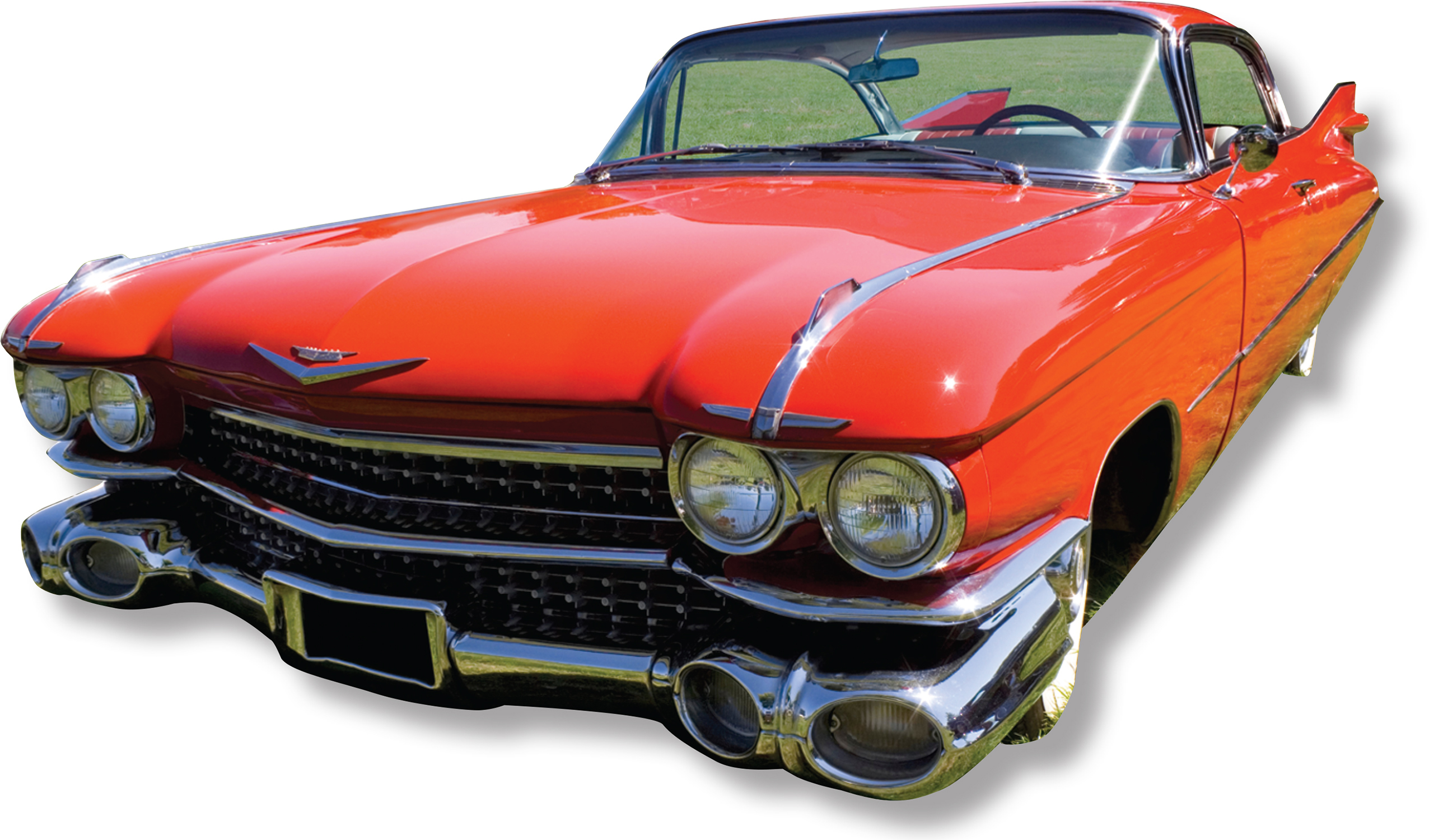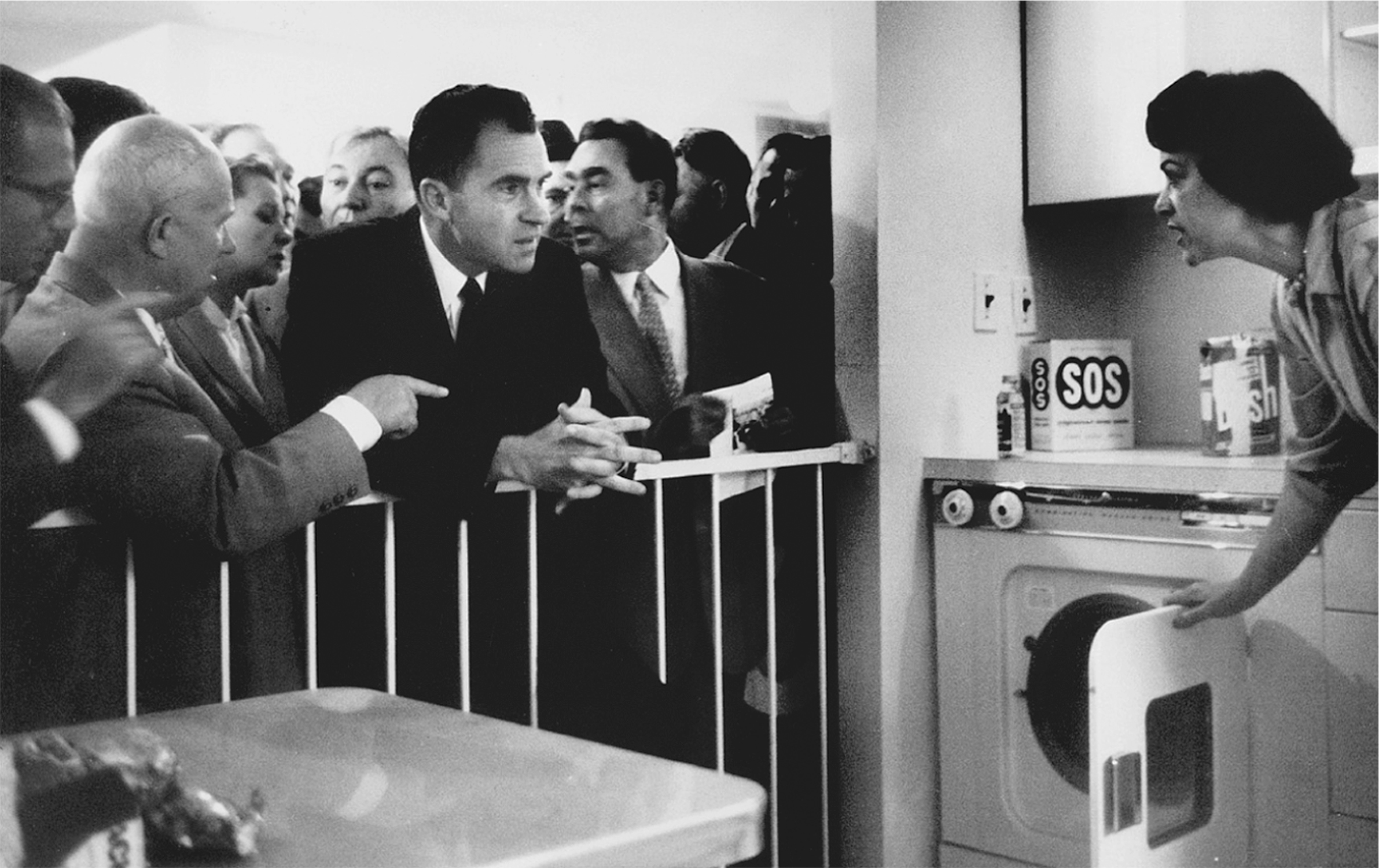The American Promise:
Printed Page 767
The American Promise Value
Edition: Printed Page 714
Chapter Chronology
Introduction for Chapter 27
The Politics and Culture of Abundance
1952–1960

1959 CADILLAC The automobile reflected 1950s prosperity and generated one of every six jobs. This Cadillac was manufactured by General Motors, the biggest and richest corporation in the world. Bill Philpot /Alamy.
CONTENT LEARNING OBJECTIVES
After reading and studying this chapter, you should be able to:
- Explain the dominant issues of the Eisenhower administration and how Eisenhower’s policies represented the politics of the “Middle Way.”
- Describe how the Eisenhower administration practiced containment and explain how the “New Look” in foreign policy influenced its handling of world events.
- Explain the factors that led to an economy of abundance and how that abundance influenced Americans’ lives.
- Analyze how the economy of abundance influenced consumption, religion, gender roles, and the media.
- Explain the origins of the modern civil rights movement and the strategies activists used to end racial segregation.
TRAILED BY REPORTERS, VICE PRESIDENT RICHARD M. NIXON LED Soviet premier Nikita Khrushchev through the American National Exhibition in Moscow in July 1959. The display of American consumer goods was part of a cultural exchange that reflected a slight thaw in the Cold War after Khrushchev replaced Stalin. In Moscow, both Khrushchev and Nixon seized on the propaganda potential of the moment. As they examined the display, they exchanged a slugfest of words and gestures that reporters dubbed the kitchen debate.
Showing off a new color television set, Nixon said the Soviet Union “may be ahead of us . . . in the thrust of your rockets,” but he insisted to Khrushchev that the United States outstripped the Soviets in consumer goods. Nixon linked capitalism with democracy, asserting that the array of products represented “what freedom means to us . . . our right to choose.” Moreover, Nixon boasted that “any steelworker could buy this house,” as they walked through a model of a six-room ranch-style home. Khrushchev retorted that in the Soviet Union “you are entitled to housing,” whereas in the United States the homeless slept on pavements.
Nixon declared that the household appliances were “designed to make things easier for our women.” Khrushchev disparaged “the capitalist attitude toward women,” maintaining that the Soviets appreciated women’s contributions to the economy, not their domesticity. Nixon got Khrushchev to agree that it was “far better to be talking about washing machines than machines of war,” yet Cold War tensions surfaced when Khrushchev later blustered, “We too are giants. You want to threaten—we will answer threats with threats.”

The Kitchen Debate Soviet premier Nikita Khrushchev (left) and Vice President Richard M. Nixon (center) debate the relative merits of their nations’ economies at the American National Exhibition held in Moscow in 1959. “You are a lawyer for capitalism and I am a lawyer for communism,” Khrushchev told Nixon as each tried to outdo the other. Howard Sochurek/ Time & Life Pictures/Getty.
In fact, the Eisenhower administration (1953–1961) had begun with threats, and the two nations engaged in an intense arms race throughout the decade and beyond. During the 1952 campaign, Republicans had vowed to roll back communism and liberate “enslaved” peoples under Soviet rule. In practice, President Dwight D. Eisenhower pursued a containment policy much like that of his predecessor, Harry S. Truman, though Eisenhower relied more on nuclear weapons and on Central Intelligence Agency (CIA) secret operations against left-leaning governments. Yet as Nixon’s visit to Moscow demonstrated, Eisenhower seized on political changes in the Soviet Union to reduce tensions in Soviet-American relations.
Continuity with the Truman administration also characterized domestic policy. Although Eisenhower favored corporations with tax cuts and resisted strong federal efforts in health care, education, and race relations, he did not try to demolish the New Deal. He even extended the reach of the federal government with a massive highway program.
Although poverty clung stubbornly to one of every five Americans, the Moscow display testified to the unheard-of material gains savored by many in the postwar era. Cold War weapons production spurred the economy, whose vitality stimulated suburban development, contributed to the growth of the South and Southwest (the Sun Belt), and enabled millions of Americans to buy a host of new products. As new homes, television sets, and household appliances transformed living patterns, Americans took part in a consumer culture that celebrated the family and traditional gender roles, even as more and more married women took jobs outside the home. Challenging the dominant norms were dissenting writers known as the Beats and an emerging youth culture.
The Cold War and the economic boom helped African Americans mount the most dramatic challenge of the 1950s, a struggle against the system of segregation and disfranchisement that had replaced slavery. Large numbers of African Americans took direct action against the institutions of injustice, developing the organizations, leadership, and strategies to mount a civil rights movement of unprecedented size and influence.
CHRONOLOGY
| 1952 |
- Dwight D. Eisenhower elected president.
|
| 1953 |
- CIA-organized coup against Iranian government.
|
| 1954 |
- CIA coup against Guatemalan government.
- Geneva accords.
- United States begins aid to South Vietnam.
- Operation Wetback.
- Hernandez v. Texas.
- Brown v. Board of Education.
- Senate condemns Senator Joseph McCarthy.
|
| 1955 |
- Eisenhower and Khrushchev meet in Geneva.
|
| 1955–1956 |
- Montgomery, Alabama, bus boycott.
|
| 1956 |
- Interstate Highway and Defense System Act.
- Eisenhower reelected.
|
| 1957 |
- Southern Christian Leadership Conference (SCLC) founded.
- Soviets launch Sputnik.
- Civil Rights Act of 1957.
|
| 1958 |
- National Aeronautics and Space Administration (NASA) established.
- National Defense Education Act.
|
| 1959 |
- Kitchen debate between Nixon and Khrushchev.
|
| 1960 |
- Soviets shoot down U.S. U-2 spy plane.
- One-quarter of Americans live in suburbs.
- Thirty-five percent of women work outside the home.
|

